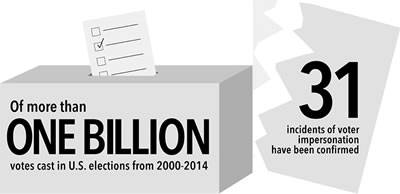Ten Things You Should Know About Voter ID Laws
This list has some essential points debunking allegations of widespread voter ID fraud. Sources include Voting Rights Watch, Ari Berman of The Nation, and voting rights advocates. Please share it with your friends, family and Facebook and Twitter communities.
 1. Voter identification laws are not bipartisan efforts. They have been initiated by Republicans, passed by Republicans, and signed into law by Republicans.
1. Voter identification laws are not bipartisan efforts. They have been initiated by Republicans, passed by Republicans, and signed into law by Republicans.
2. The U.S. voters who are most likely to be burdened by these new voting restrictions lean heavily toward the Democratic Party. Eleven percent of U.S. citizens (21 million Americans) do not have government-issued photo identification and minority voters disproportionately lack the required ID.
3. The Brennan Center has estimated that as many as 3.2 million citizens could find it harder to vote because of new voter ID laws.
4. Restrictions on voting, like poll taxes and “literacy” tests, have a long and dark history. They are used by one party to prevent supporters of another party from voting.
5. The forms of ID allowed are discriminatory. As one example, Texas allows concealed weapons permits for voting but does not accept student ID cards.
6. Obtaining an ID costs money. Even if ID is offered for free, voters must incur costs, such as paying for birth certificates, to apply for a government-issued ID. The combined cost of document fees, travel expenses and waiting time are estimated to range from $75 to $175.
7. The travel required is often a major burden on people with disabilities, the elderly, or those in rural areas without access to a vehicle or public transportation. People in rural areas must travel long distances to reach the nearest ID office. In Texas it can be approximately 170 miles each way.
8. Thirty-four states have voter identification requirements. Seven states have strict photo ID laws that require voters to present one of a limited set of forms of government-issued photo ID before a ballot can be cast. They provide no exceptions.
9. In-person fraud is extremely rare. A study from the University of California San Diego found that between 2000 to 2014 there were only 31 credible allegations of voter impersonation fraud. That is the only type of fraud that photo IDs can prevent. During those 16 years there were over 1 billion ballots cast in the United States.
10. If someone were trying to steal an election, in-person voter fraud (pretending to be someone else) would be highly inefficient. Absentee ballot stuffing is far easier. Because statistics show that more Republicans vote by absentee ballot no new restrictions on absentee voting have been proposed.
